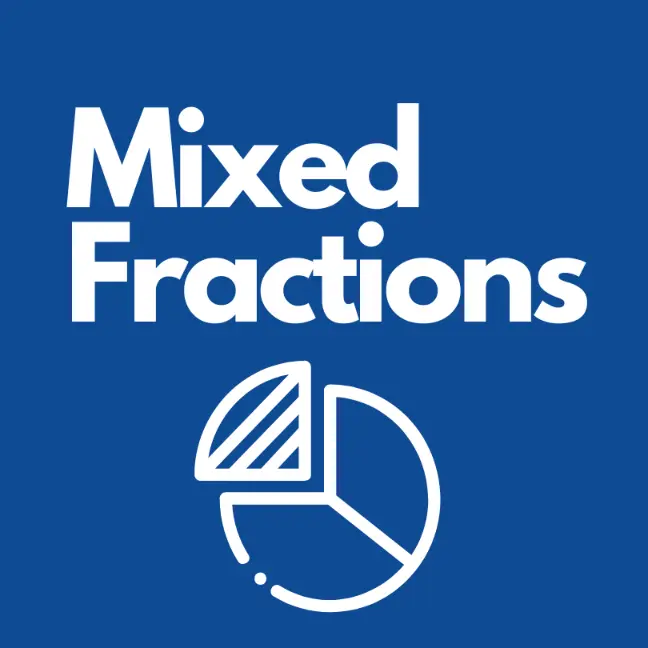Mixed Number to Improper Fraction
Enter a mixed number to convert to an improper fraction
Related Mixed Fraction Calculators
See all maths calculators
Mixed Number to Improper Fraction Guide
Converting mixed numbers to improper fractions is a fundamental mathematical skill that plays a crucial role in various calculations and problem-solving scenarios. This comprehensive guide will walk you through the process of converting mixed numbers to improper fractions, provide practical examples, and offer insights into common pitfalls and real-world applications.
Understanding Mixed Numbers and Improper Fractions
Before diving into the conversion process, it's essential to understand what mixed numbers and improper fractions are:
Mixed Numbers
A mixed number is a combination of a whole number and a proper fraction. For example, 3 1/4 is a mixed number where 3 is the whole number part and 1/4 is the fractional part.
Improper Fractions
An improper fraction is a fraction where the numerator (top number) is greater than or equal to the denominator (bottom number). For example, 7/4 is an improper fraction.
The Conversion Process: From Mixed Numbers to Improper Fractions
Converting a mixed number to an improper fraction involves three main steps:
Step 1: Multiply the Whole Number by the Denominator
First, multiply the whole number part of the mixed number by the denominator of the fractional part.
Step 2: Add the Result to the Numerator
Next, add the result from step 1 to the numerator of the fractional part.
Step 3: Write the Sum Over the Original Denominator
Finally, write the sum from step 2 over the original denominator to form the improper fraction.
Let's illustrate this process with an example:
Convert 3 1/4 to an improper fraction:
- 3 × 4 = 12
- 12 + 1 = 13
- 13/4
Therefore, 3 1/4 as an improper fraction is 13/4.
Examples of Mixed Number to Improper Fraction Conversions
To better understand the process, let's look at a table of mixed number to improper fraction conversions:
| Mixed Number | Calculation | Improper Fraction |
|---|---|---|
| 2 3/5 | (2 × 5) + 3 = 13/5 | 13/5 |
| 4 1/3 | (4 × 3) + 1 = 13/3 | 13/3 |
| 1 7/8 | (1 × 8) + 7 = 15/8 | 15/8 |
| 5 2/3 | (5 × 3) + 2 = 17/3 | 17/3 |
| 3 1/2 | (3 × 2) + 1 = 7/2 | 7/2 |
| 6 3/4 | (6 × 4) + 3 = 27/4 | 27/4 |
Common Mistakes to Avoid
When converting mixed numbers to improper fractions, there are several common mistakes to be aware of:
-
Forgetting to multiply the whole number by the denominator: This is perhaps the most common error. Remember, you must multiply the whole number by the denominator before adding the numerator.
-
Adding the whole number to the numerator directly: Simply adding the whole number to the numerator without multiplying by the denominator first will result in an incorrect answer.
-
Changing the denominator: The denominator of the improper fraction should always be the same as the denominator of the fractional part in the mixed number.
-
Incorrect order of operations: Make sure to perform the multiplication before the addition when calculating the new numerator.
Practical Applications
Understanding how to convert mixed numbers to improper fractions has numerous real-world applications:
Mathematics and Problem Solving
Many mathematical operations, especially division and multiplication of fractions, are easier to perform with improper fractions rather than mixed numbers.
Cooking and Baking
When scaling recipes, it's often easier to work with improper fractions. For example, if you need to triple a recipe that calls for 1 1/3 cups of flour, it's easier to work with 4/3 cups and triple it to 12/3 cups (which can then be simplified to 4 cups).
Construction and Carpentry
In construction and carpentry, measurements are often given in mixed numbers. Converting these to improper fractions can be helpful when performing calculations or when using certain tools.
Science and Engineering
In scientific and engineering calculations, improper fractions are often preferred for their precision and ease of use in formulas and equations.
Using Technology: Mixed Number to Improper Fraction Calculators
While it's important to understand the manual process, there are many online tools and calculators available that can quickly convert mixed numbers to improper fractions. These tools can be particularly useful for complex calculations or when dealing with large numbers.
When using such calculators, it's important to:
- Verify the input format required by the calculator.
- Double-check your entries for accuracy.
- Understand the output format provided by the calculator.
- Use the results judiciously, especially in professional or academic contexts where showing your work may be required.
The Importance of Understanding Fractions
Fractions, both in mixed number and improper form, are a fundamental concept in mathematics. They provide a way to express parts of a whole and are essential for many types of calculations. By mastering the conversion between mixed numbers and improper fractions, you enhance your numerical literacy and problem-solving skills.
Simplifying Improper Fractions
After converting a mixed number to an improper fraction, it's often useful to simplify the resulting fraction if possible. To simplify a fraction:
- Find the greatest common divisor (GCD) of the numerator and denominator.
- Divide both the numerator and denominator by the GCD.
For example, if we convert 3 1/4 to 13/4, we can't simplify it further because 13 and 4 have no common factors other than 1.
However, if we convert 2 2/6 to an improper fraction:
- (2 × 6) + 2 = 14
- 14/6
We can simplify 14/6 by dividing both the numerator and denominator by their GCD of 2:
14 ÷ 2 = 7
6 ÷ 2 = 3
So, 2 2/6 simplifies to the improper fraction 7/3.
Conclusion
Converting mixed numbers to improper fractions is a valuable skill that enhances your ability to work with fractional quantities. Whether you're a student, a professional, or simply someone who enjoys working with numbers, understanding this process can improve your mathematical capabilities and practical problem-solving skills.
Remember, practice is key to mastering this conversion process. Start with simple mixed numbers and gradually work your way up to more complex ones. With time and practice, you'll find that converting mixed numbers to improper fractions becomes second nature.
Key Takeaways
- A mixed number consists of a whole number and a proper fraction.
- An improper fraction has a numerator greater than or equal to its denominator.
- To convert a mixed number to an improper fraction, multiply the whole number by the denominator, add the numerator, and put this sum over the original denominator.
- Common mistakes include forgetting to multiply by the denominator and changing the denominator.
- This skill has practical applications in mathematics, cooking, construction, and science.
- While calculators are available, understanding the manual process is crucial for developing mathematical intuition.
- After conversion, it's often useful to simplify the resulting improper fraction if possible.
By mastering the conversion of mixed numbers to improper fractions, you'll have a powerful tool at your disposal for various mathematical operations and real-world problem-solving scenarios.

